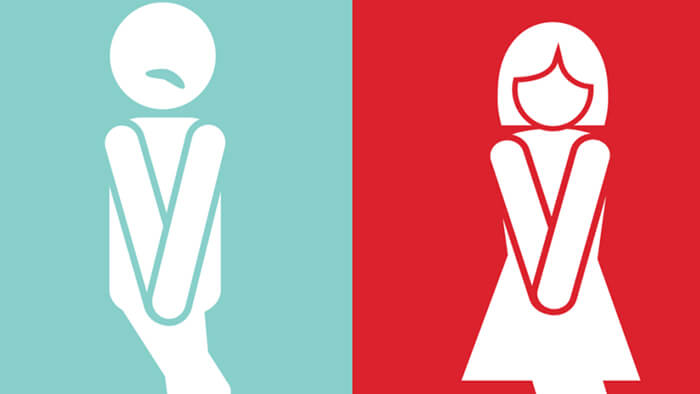UTI Symptoms and Diagnosis

What Is a Urinary Tract Infection?
Your urinary system includes your urethra, ureters, bladder, and kidneys. A urinary tract infection, or UTI, is an infection affecting one or more parts of this delicate system. Unfortunately, as many as 50% of women will experience a UTI in their lifetime (compared to 10% of men), many women suffer repeat infections for years.
Symptoms of a Urinary Tract Infection (UTI)
- Strong and frequent urge to urinate;
- Pain or a burning sensation when you pee;
- Cloudy, bloody, or strong-smelling urine;
- Fever and chills;
- Nausea and vomiting;
- Feeling very tired or shaking;
- Muscle aches, abdominal pain or lower back pain.
 If you feel any or all of these symptoms, the next step is to confirm whether they're caused by a urinary tract infection.
If you feel any or all of these symptoms, the next step is to confirm whether they're caused by a urinary tract infection.
What Are the Causes of a UTI?
Simply put, UTIs are caused when bacteria enters the urinary tract, often through the urethra, and begin to multiply in the bladder. Once there, these unwelcome invaders can develop into a severe UTI. Common UTI causes include:
- Proximity to the anus. The urethra is located very close to the anus, which means bacteria from the large intestine can sometimes travel and find its way into your urethra, your bladder and, if left treated, even your kidneys.
- Short urethras. It’s a matter of simple anatomy: women have shorter urethras than men do, making it easier for bacteria to end up in their bladders.
Sexual intercourse. Believe it or not, the simple act of having sex can introduce bacteria into your urinary tract as well.
What Are the Types of Urinary Tract Infection?
There are several different types of UTIs based on where in your urinary tract the infection is located.
- Urethritis affects the urethra. Symptoms of this UTI type include discharge and burning when you pee.
- Cystitis affects the bladder. Symptoms include the sensation of having to pee frequently, painful urination, lower abdominal pain, and cloudy or bloody urine.
- Pyelonephritis affects the kidneys. Symptoms include nausea, fever, chills, vomiting, and pain in your side or back.
How to Diagnose a Urinary Tract Infection (UTI)
If this is the first time you've felt these symptoms, you'll need to go see a doctor as soon as possible. During your appointment, the doctor will analyze a urine sample with a simple test called urinalysis. During this test, the doctor will examine the urine to determine whether it contains any compounds that shouldn't be there, which would indicate the presence of an infection.
It's important to mention that a urinalysis will only confirm the presence of an infection, not what type of bacteria that caused it. Why is that important? Urinary tract infections can be caused by several types of bacteria which require different antibiotics to treat each one. Once the presence of a UTI is confirmed, you have to identify which strain of bacteria is causing the UTI through a urine culture.
The urine culture takes a few days to complete but will let your doctor know what types of antibiotics to prescribe in order to treat the infection.
What Are the Risks & Complications of a UTI?
There are a number of risk factors that might increase your chances of getting a UTI. These include:
- Having recently introduced a new sexual partner
- Some types of birth control, such as diaphragms or spermicide
- Hormonal causes like the decline in estrogen associated with menopause
- Urinary tract blockages like kidney stones or an enlarged prostate
- A weakened immune system
When treated without delay, UTIs rarely lead to complications. However, if left untreated, they can have severe consequences, including:
- Repeat infections
- Permanent kidney damage
- Urethral narrowing among men
- Sepsis, a potentially life-threatening complication, particularly if the infection travels to the kidneys
At-Home UTI Diagnosis
If you've been through the UTI rigmarole several times already, you're likely very sensitive to even the slightest symptom — whether you're suffering from an infection or not. There's little worse than the mental dance that ensues: should you go to the doctor or wait it out a little longer?
Luckily, there's an easy way to find out with Utiva UTI Test Strips. These test strips are approved as a consumer version of the same urine dipstick used in labs and clinics. They are a simple, accurate and convenient way to test for leukocytes and nitrites in urine, two compounds that signal the presence of a UTI*.
| Hold the test strip in the urine stream for 1 or 2 seconds. | |
| Wait one minute to test for nitrites, two minutes for leukocytes. | |
| Compare your results with the chart. |
Keep them around the house to know for sure and stop the "Should I?" questions right in their track!
How to Prevent a UTI
To reduce the likelihood that you will have to suffer through the agony of a UTI, consider the following precautionary measures:
- Pee immediately after sex. After sexual intercourse, always empty your bladder right away.
- Stay well-hydrated. Water dilutes your urine and makes you pee more often, which flushes out bacteria before an infection can manifest.
- Wipe from front to back. Wiping away from your urethra after going to the bathroom helps stop bacteria in the anus from traveling to the urethra.
- Take Utiva Cranberry PACs. Utiva has 36mg of proanthocyanidins (PACs), the clinically proven amount that prevents bacteria from adhering to the bladder wall and causing an infection. Equal in strength to 4 glasses of cranberry juice or 9 regular cranberry pills, Utiva is doctor recommended & approved by Health Canada.
Knowledge is power
Sign up to our newsletter to keep learning!

- Choosing a selection results in a full page refresh.
- Opens in a new window.




